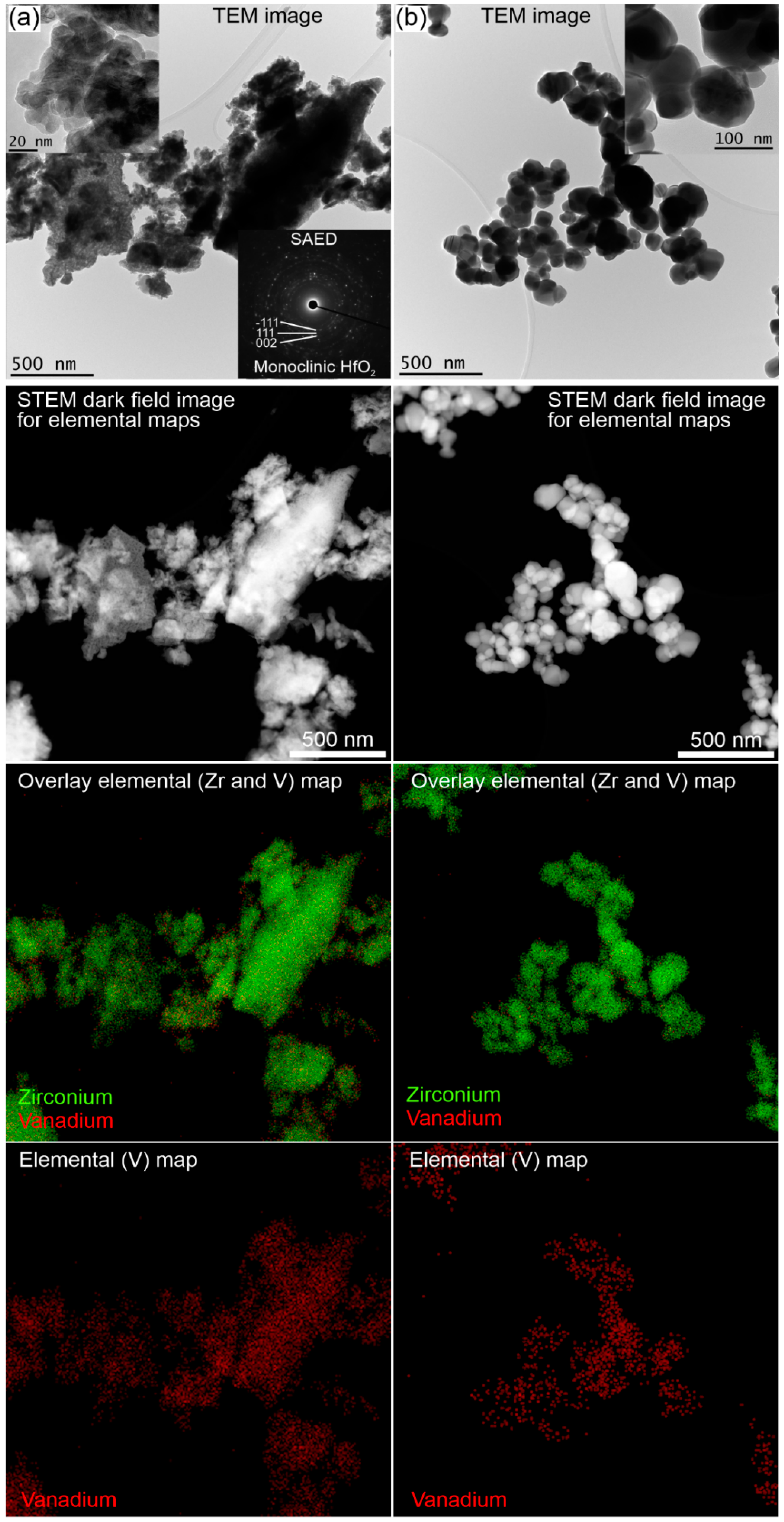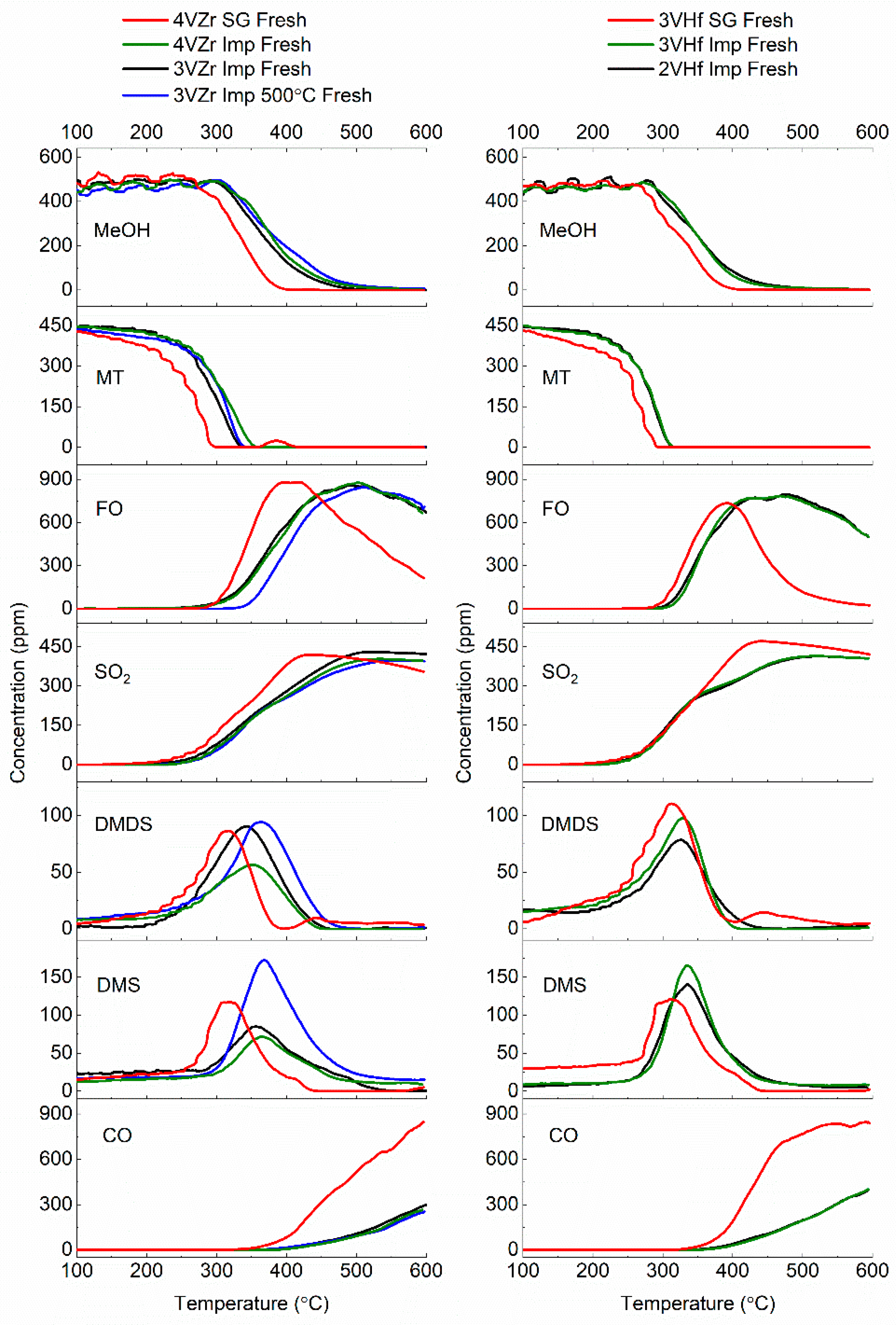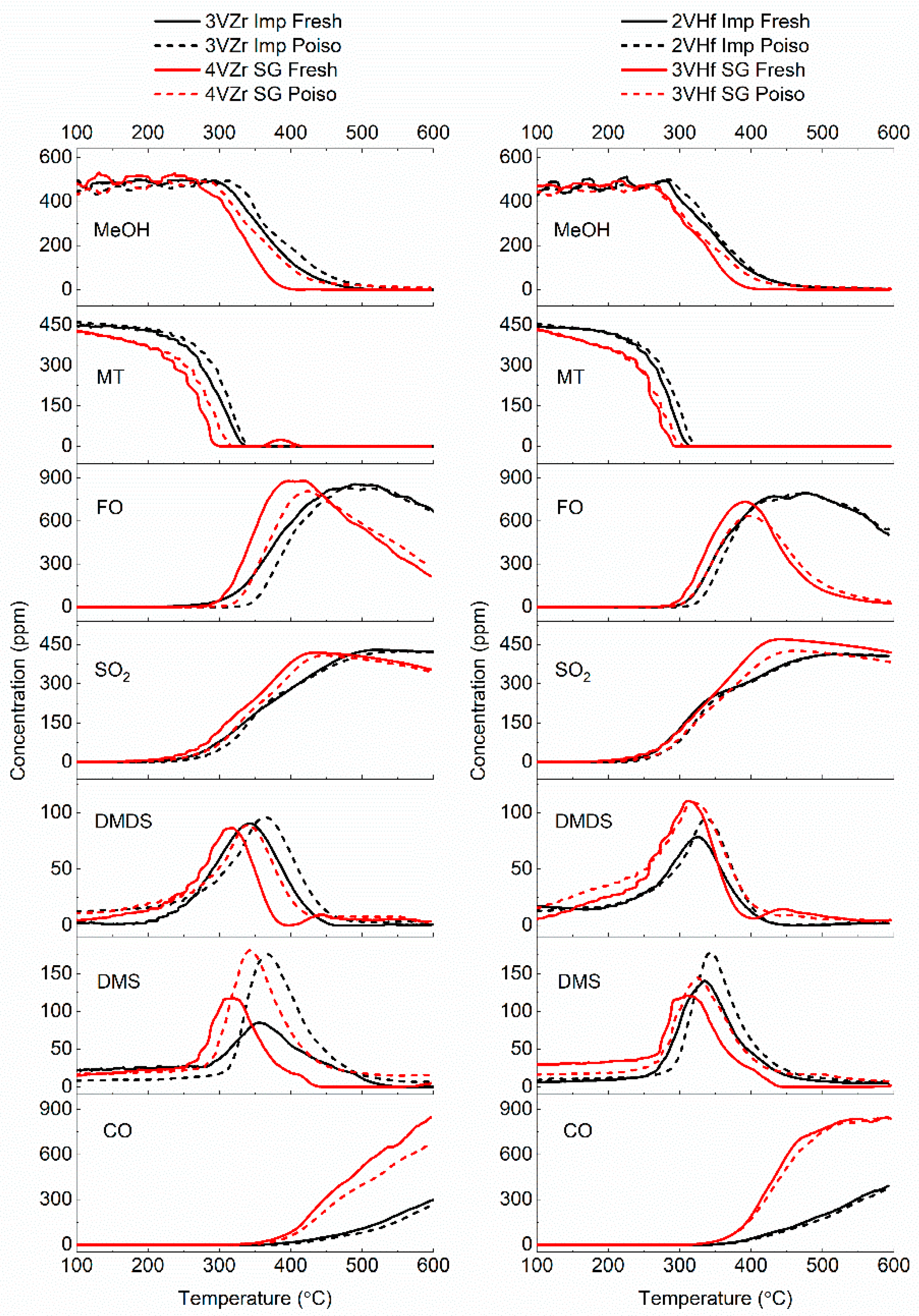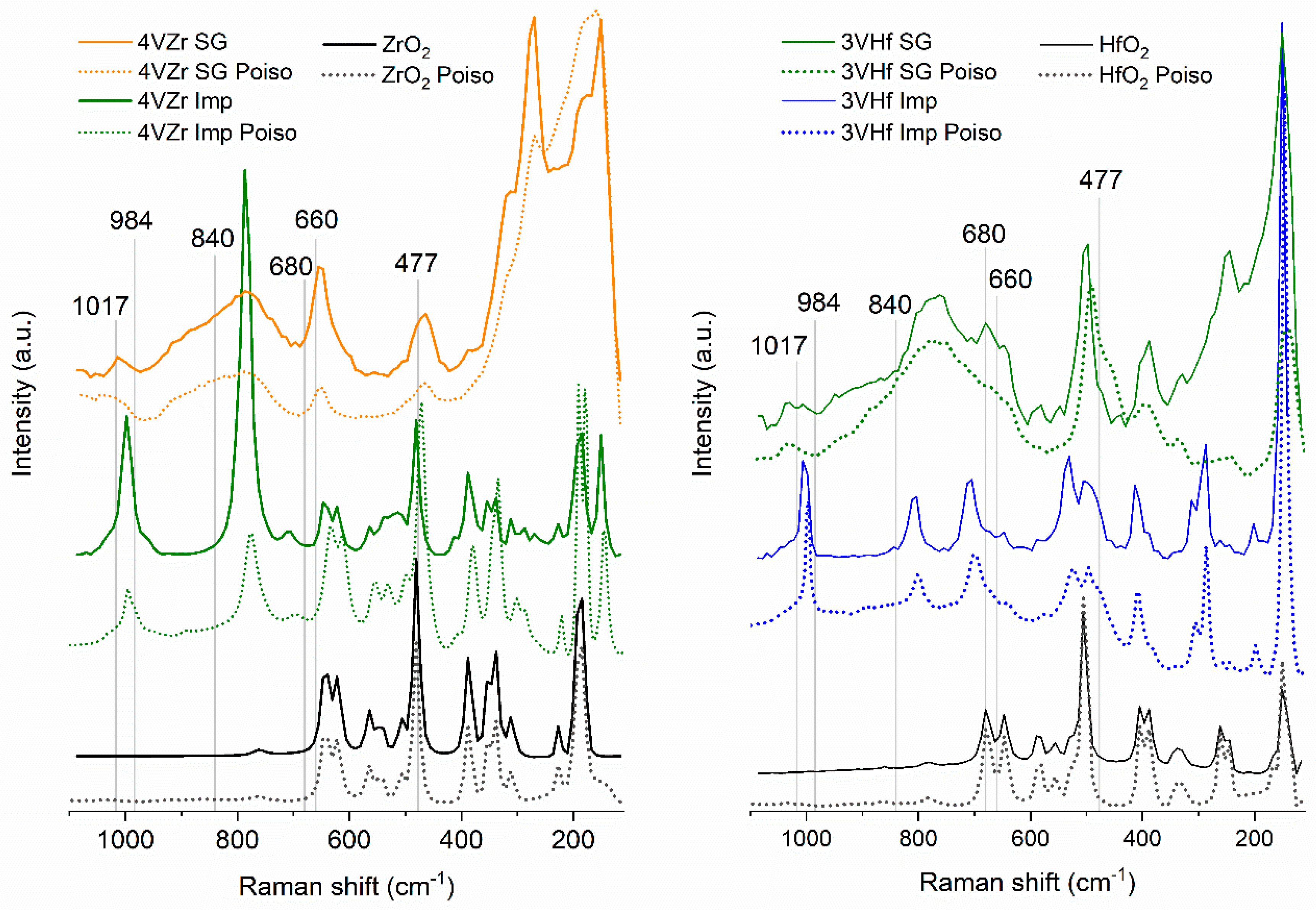Vanadia–Zirconia and Vanadia–Hafnia Catalysts for Utilization of Volatile Organic Compound Emissions
Abstract
:1. Introduction
2. Materials and Methods
2.1. Preparation of the Catalysts
2.2. Characterization
2.3. Catalyst Activity Studies
2.4. Poisoning Treatment
3. Results and Discussion
3.1. Characterization
3.2. Production of Formaldehyde from Methanol and Methanethiol Mixture
4. Conclusions
- vanadia species of dehydrated catalysts differ from each other depending on calcination temperature and preparation method. Impregnation leads to formation of V2O5 at calcination temperature of 500 °C. At higher calcination temperature (600 °C), vanadia is integrated in the support oxide structure, forming either ZrV2O7 or HfV2O7 depending on the support used. At higher vanadia loading, V2O5 may co-exist with metal mixed oxide structure.
- The major changes in the vanadia species of impregnated catalysts were solely dependent on the calcination temperature and no phase change of the bulk of the support was observed based on XRD and (S)TEM analysis. Raman analysis was able to reveal the formation of support defect sites that could help in formation of crystalline metal-mixed oxide phases.
- The sol–gel preparation of corresponding catalysts leads to formation of mono- and polymeric vanadia species. The hafnia takes a monoclinic structure, while zirconia also contains tetragonal phase in the sol–gel prepared sample. XRD and Raman analyses did not clearly evidence the presence of metal-mixed oxide structure in the case of sol–gel prepared catalysts.
- Impregnation of vanadia leads to a poorer distribution of vanadium on the support, which is especially visible in the catalyst calcined at 500 °C. Poorer distribution increases vanadia surface concentration locally and crystalline V2O5 is formed. A higher calcination temperature (600 °C) which is closer to vanadia melting point helps in dispersing vanadia more effectively, and metal-mixed oxide phases are formed. The reaction experiments showed the slightly higher activity of the sol–gel prepared catalysts, which arise from the presence of mono- and polymeric vanadia species.
- The results did not indicate higher activity of crystalline metal-mixed oxide phases compared with amorphous mono- and polymeric vanadia phases.
- While all the catalysts were rather stable towards sulfur poisoning, the sol–gel prepared samples retained a higher amount of sulfur, and their performances were decreased slightly after the poisoning treatment. It seems that more active mono- and polymeric vanadia species are more susceptible for the poisoning than V2O5 and metal-mixed oxide species, due to competing reactions of methanol and SO2 on the same active V-O-support site.
Supplementary Materials
Author Contributions
Funding
Institutional Review Board Statement
Informed Consent Statement
Data Availability Statement
Acknowledgments
Conflicts of Interest
References
- Ojala, S.; Koivikko, N.; Laitinen, T.; Mouammine, A.; Seelam, P.K.; Laassiri, S.; Ainassaari, K.; Brahmi, R.; Keiski, R.L. Utilization of Volatile Organic Compounds as an Alternative for Destructive Abatement. Catalysts 2015, 5, 1092–1151. [Google Scholar] [CrossRef] [Green Version]
- Dogu, D.; Sohn, H.; Bhattacharya, S.; Cornelius, C.; Ozkan, U.S. Using Volatile Organic Compounds in Waste Streams as Fuel. Int. J. Chem. React. Eng. 2019, 17. [Google Scholar] [CrossRef]
- Wachs, I.E. Treating Methanol-Containing Waste Gas Streams. U.S. Patent 5907066, 25 May 1999. [Google Scholar]
- Laitinen, T.; Ojala, S.; Genty, E.; Brunet, J.; De Weireld, G.; Poupin, C.; Siffert, S.; Cousin, R.; Keiski, R.L. On the activity and selectivity of coal and coalce mixed oxides in formaldehyde production from pulp mill emissions. Catalysts 2020, 10, 424. [Google Scholar] [CrossRef]
- Koivikko, N.; Laitinen, T.; Ojala, S.; Pitkäaho, S.; Kucherov, A.; Keiski, R.L. Formaldehyde production from methanol and methyl mercaptan over titania and vanadia based catalysts. Appl. Catal. B: Environ. 2011, 103, 72–78. [Google Scholar] [CrossRef]
- Laitinen, T.; Ojala, S.; Cousin, R.; Koivikko, N.; Poupin, C.; El Assal, Z.; Aho, A.; Keiski, R.L. Activity, selectivity, and stability of vanadium catalysts in formaldehyde production from emissionsof volatile organic compounds. J. Ind. Eng. Chem. 2020, 83, 375–386. [Google Scholar] [CrossRef]
- Nielsen, R.H.; Wilfing, G. Hafnium and Hafnium Compounds. In Ullmann’s Encyclopedia of Industrial Chemistry; Wiley-VCH Verlag GmbH & Co. KGaA: Weinheim, Germany, 2010. [Google Scholar]
- Nielsen, R.H.; Wilfing, G. Zirconium and Zirconium Compounds. In Ullmann’s Encyclopedia of Industrial Chemistry; Wiley-VCH Verlag GmbH & Co. KGaA: Weinheim, Germany, 2010; pp. 753–778. [Google Scholar]
- Yang, Y.-L.; Fan, X.-L.; Liu, C.; Ran, R.-X. First principles study of structural and electronic properties of cubic phase of ZrO2 and HfO2. Phys. B Condens. Matter 2014, 434, 7–13. [Google Scholar] [CrossRef]
- Miikkulainen, V.; Leskelä, M.; Ritala, M.; Puurunen, R.L. Crystallinity of inorganic films grown by atomic layer deposition: Overview and general trends. J. Appl. Phys. 2013, 113. [Google Scholar] [CrossRef]
- Holleman, A.F.; Egon, W.; NILS, W. Lehrbuch der Anorganischen Chemie, 91–100 ed.; De Gruyter: Berlin, Germany, 1985; pp. 1056–1057. [Google Scholar]
- Di Monte, R.; Kašpar, J. Heterogeneous environmental catalysis—A gentle art: CeO2–ZrO2 mixed oxides as a case history. Catal. Today 2005, 100, 27–35. [Google Scholar] [CrossRef]
- Wilk, G.D.; Wallace, R.M.; Anthony, J.M. High-κ gate dielectrics: Current status and materials properties considerations. J. Appl. Phys. 2001, 89, 5243–5275. [Google Scholar] [CrossRef]
- Kosmulski, M. The pH dependent surface charging and points of zero charge. VIII. Update. Adv. Colloid Interface Sci. 2020, 275, 102064. [Google Scholar] [CrossRef]
- Kosmulski, M. Attempt to determine pristine points of zero charge of Nb2O5, Ta2O5, and HfO2. Langmuir 1997, 13, 6315–6320. [Google Scholar] [CrossRef]
- Wachs, I.E. Catalysis science of supported vanadium oxide catalysts. Dalton Trans. 2013, 42, 11762–11769. [Google Scholar] [CrossRef]
- Kuang, Q.; Zhao, Y.; Dong, Y.; Fan, Q. Sol-gel synthesized zirconium pyrovanadate as a high-capacity cathode for rechargeable Li batteries. Electrochim. Acta 2015, 170, 229–233. [Google Scholar] [CrossRef]
- Liu, Q.; Yang, J.; Rong, X.; Sun, X.; Cheng, X.; Tang, H.; Li, H. Structural, negative thermal expansion and photocatalytic properties of ZrV2O7: A comparative study between fibers and powders. Mater. Charact. 2014, 96, 63–70. [Google Scholar] [CrossRef]
- Kidchob, T.; Malfatti, L.; Serra, F.; Falcaro, P.; Enzo, S.; Innocenzi, P. Hafnia sol-gel films synthesized from HfCl4: Changes of structure and properties with the firing temperature. J. Sol-Gel Sci. Technol. 2007, 42, 89–93. [Google Scholar] [CrossRef]
- Yan, X.; Su, D.; Duan, H.; Zhang, F. Preparation of SiOC/HfO2 fibers from silicon alkoxides and tetrachloride hafnium by a sol–gel process. Mater. Lett. 2015, 148, 196–199. [Google Scholar] [CrossRef]
- Ojala, S.; Lassi, U.; Ylönen, R.; Keiski, R.; Laakso, I.; Maunula, T. Abatement of malodorous pulp mill emissions by catalytic oxidation—Pilot experiments in Stora Enso Pulp Mill, Oulu, Finland. TAPPI J. 2005, 4, 9–14. [Google Scholar]
- Khodakov, A.; Olthof, B.; Bell, A.T.; Iglesia, E. Structure and Catalytic properties of supported vanadium oxides: Support Effects on oxidative dehydrogenation reactions. J. Catal. 1999, 181, 205–216. [Google Scholar] [CrossRef] [Green Version]
- Olthof, B.; Khodakov, A.; Bell, A.T.; Iglesia, E. Effects of Support Composition and Pretreatment Conditions on the Structure of Vanadia Dispersed on SiO2, Al2O3, TiO2, ZrO2, and HfO2. J. Phys. Chem. B 2000, 104, 1516–1528. [Google Scholar] [CrossRef]
- Basahel, S.N.; Ali, T.T.; Mokhtar, M.; Narasimharao, K. Influence of crystal structure of nanosized ZrO2 on photocatalytic degradation of methyl orange. Nanoscale Res. Lett. 2015, 10, 1–13. [Google Scholar] [CrossRef] [Green Version]
- Riemer, T.; Spielbauer, D.; Hunger, M.; Mekhemer, G.A.H.; Knözinger, H. Superacid properties of sulfated zirconia as measured by Raman and1H MAS NMR spectroscopy. J. Chem. Soc. Chem. Commun. 1994, 1181–1182. [Google Scholar] [CrossRef]
- Benomar, S.; Massó, A.; Solsona, B.; Issaadi, R.; Nieto, J.M. Vanadium supported on alumina and/or zirconia catalysts for the selective transformation of ethane and methanol. Catalysts 2018, 8, 126. [Google Scholar] [CrossRef] [Green Version]
- Zhou, B.; Shi, H.; Zhang, X.D.; Su, Q.; Jiang, Z.Y. The simulated vibrational spectra of HfO2 polymorphs. J. Phys. D Appl. Phys. 2014, 47, 115502. [Google Scholar] [CrossRef]
- Ciszak, C.; Mermoux, M.; Gutierrez, G.; Leprêtre, F.; Duriez, C.; Popa, I.; Fayette, L.; Chevalier, S. Raman spectra analysis of ZrO2 thermally grown on Zircaloy substrates irradiated with heavy ion: Effects of oxygen isotopic substitution. J. Raman Spectrosc. 2019, 50, 425–435. [Google Scholar] [CrossRef]
- Christodoulakis, A.; Machli, M.; Lemonidou, A.A.; Boghosian, S. Molecular structure and reactivity of vanadia-based catalysts for propane oxidative dehydrogenation studied by in situ Raman spectroscopy and catalytic activity measurements. J. Catal. 2004, 222, 293–306. [Google Scholar] [CrossRef]
- Reuss, G.; Disteldorf, W.; Gamer, A.O.; Hilt, A. Formaldehyde. Ulmann’s Encycl. Ind. Chem. 2012, 15, 735–768. [Google Scholar]
- Burgess, T.L.; Gibson, A.G.; Furstein, S.J.; Wachs, I.E. Converting waste gases from pulp mills into value-added chemicals. Environ. Prog. 2002, 21, 137–141. [Google Scholar] [CrossRef]
- Dalai, A.K.; Tollefson, E.L.; Yang, A.; Sasaoka, E. Oxidation of Methyl Mercaptan over an Activated Carbon in a Fixed-Bed Reactor. Ind. Eng. Chem. Res. 1997, 36, 4726–4733. [Google Scholar] [CrossRef]
- Koivikko, N.; Laitinen, T.; Mouammine, A.; Ojala, S.; Keiski, R.L. Catalytic Activity Studies of Vanadia/Silica–Titania Catalysts in SVOC Partial Oxidation to Formaldehyde: Focus on the Catalyst Composition. Catalysts 2018, 8, 56. [Google Scholar] [CrossRef] [Green Version]
- Periodic Table of the Elements. Available online: https://pubchem.ncbi.nlm.nih.gov/periodic-table/ (accessed on 23 August 2021).
- Dunn, J.P.; Stenger, H.G.; Wachs, I.E. Molecular structure–reactivity relationships for the oxidation of sulfur dioxide over supported metal oxide catalysts. Catal. Today 1999, 53, 543–556. [Google Scholar] [CrossRef]
- Kausar, N.; Howe, R.; Skyllas-Kazacos, M. Raman spectroscopy studies of concentrated vanadium redox battery positive electrolytes. J. Appl. Electrochem. 2001, 31, 1327–1332. [Google Scholar] [CrossRef]







| Sample | Specific Surface Area (m2g−1) | Total Pore Volume (cm3g−1) | Average Pore Size (nm) | V2O5 Amount (wt-%) | VOx Surface Density (V nm−2) |
|---|---|---|---|---|---|
| ZrO2 | 5.0 | 0.019 | 15.6 | - | - |
| 4VZr SG | 5.2 | 0.013 | 9.6 | 4.2 | 55 |
| 4VZr Imp | 2.9 | 0.015 | 20.5 | 4.2 | 96 |
| 3VZr Imp | 2.9 | 0.016 | 21.9 | 2.8 | 66 |
| 3VZr Imp 500 °C | 4.7 | 0.025 | 21.0 | 2.8 | 39 |
| HfO2 | 4.9 | 0.034 | 27.8 | - | - |
| 3VHf SG | 16.6 | 0.034 | 8.3 | 3.2 | 13 |
| 3VHf Imp | 5.2 | 0.036 | 27.2 | 3.5 | 45 |
| 2VHf Imp | 4.6 | 0.026 | 22.3 | 2.0 | 24 |
| Poisoned Sample (SO2 + H2O at 400 °C) | Amount of Sulfur (wt.%) |
|---|---|
| ZrO2 | 0.05 |
| 4VZr SG | 0.23 |
| 4VZr Imp | 0.02 |
| 3VZr Imp | 0.03 |
| 3VZr Imp 500 °C | 0.02 |
| HfO2 | 0.05 |
| 3VHf SG | 0.10 |
| 3VHf Imp | 0.03 |
| 2VHf Imp | 0.02 |
Publisher’s Note: MDPI stays neutral with regard to jurisdictional claims in published maps and institutional affiliations. |
© 2021 by the authors. Licensee MDPI, Basel, Switzerland. This article is an open access article distributed under the terms and conditions of the Creative Commons Attribution (CC BY) license (https://creativecommons.org/licenses/by/4.0/).
Share and Cite
Ojala, S.; Laitinen, T.; Leneuf de Neufville, S.; Honkanen, M.; Vippola, M.; Huuhtanen, M.; Keiski, R.L. Vanadia–Zirconia and Vanadia–Hafnia Catalysts for Utilization of Volatile Organic Compound Emissions. Materials 2021, 14, 5265. https://doi.org/10.3390/ma14185265
Ojala S, Laitinen T, Leneuf de Neufville S, Honkanen M, Vippola M, Huuhtanen M, Keiski RL. Vanadia–Zirconia and Vanadia–Hafnia Catalysts for Utilization of Volatile Organic Compound Emissions. Materials. 2021; 14(18):5265. https://doi.org/10.3390/ma14185265
Chicago/Turabian StyleOjala, Satu, Tiina Laitinen, Sian Leneuf de Neufville, Mari Honkanen, Minnamari Vippola, Mika Huuhtanen, and Riitta L. Keiski. 2021. "Vanadia–Zirconia and Vanadia–Hafnia Catalysts for Utilization of Volatile Organic Compound Emissions" Materials 14, no. 18: 5265. https://doi.org/10.3390/ma14185265
APA StyleOjala, S., Laitinen, T., Leneuf de Neufville, S., Honkanen, M., Vippola, M., Huuhtanen, M., & Keiski, R. L. (2021). Vanadia–Zirconia and Vanadia–Hafnia Catalysts for Utilization of Volatile Organic Compound Emissions. Materials, 14(18), 5265. https://doi.org/10.3390/ma14185265









